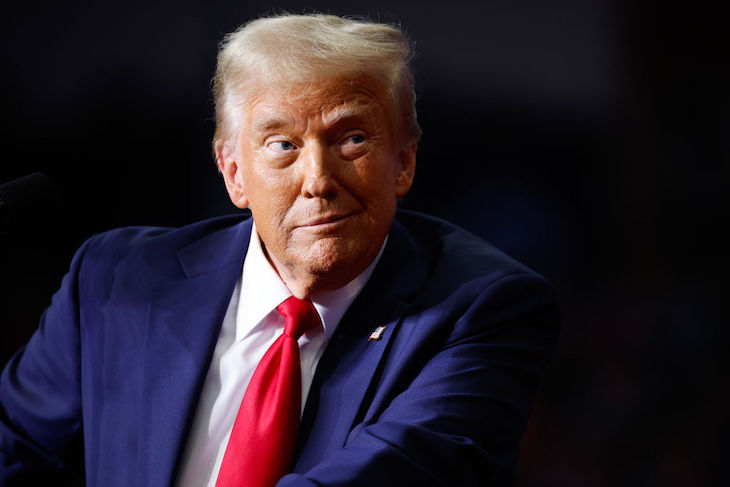Greenland’s prime minister Múte Egede has responded to Donald Trump’s overtures to buy the island by saying it is time to shake off ‘the shackles of colonialism’ and hold an independence referendum. As Egede works out how to proceed on the path to independence from Denmark, and how to respond to Trump as he prepares to take office, he would be advised to do a little background reading. For Donald Trump’s policies are increasingly informed by his key lieutenant, Elon Musk; Musk’s friend and fellow PayPal co-founder Ken Howery will be the next US Ambassador to Denmark; and Musk’s key philosophical text is The Hitchhiker’s Guide to the Galaxy, which reminds us:
‘Space is big. You just won’t believe how vastly, hugely, mind-bogglingly big it is. I mean, you may think it’s a long way down the road to the chemist’s, but that’s just peanuts to space.’
Greenland’s sovereign protector, Denmark, is itself a strategic minnow
Greenland, too, is superlatively big: it’s the world’s largest island, with a landmass approaching the size of India. Yet its mostly Inuit population is minuscule, at just 57,000, and it relies on Denmark for over half its budget – which features the same expensive welfare benefits enjoyed by other Danes. The juxtaposition of enormous geographic area with puny local resources recalls the fate of the warrior Vl’hurg race in the Guide:
‘[Their warships] tore across the empty wastes of space and finally dived screaming on to the first planet they came across – which happened to be Earth – where due to a terrible miscalculation of scale the entire battle fleet was accidentally swallowed by a small dog.’
The security prospects of a genuinely independent Greenland, then, may be said to be no better than the Vl’hurgs’s (or indeed a small dog’s). Worse still, Greenland’s sovereign protector, Denmark, is itself a strategic minnow, accounting for just 0.2 per cent of global defence spending, yet – via Greenland – Denmark is also a player in the Arctic Great Game now being played out between the US (39 per cent of global defence spending), China (13 per cent) and Russia (4 per cent). There are more US troops in Greenland – mostly at Pituffik Space Base – than Danes. Little wonder Trump senses, amid the collective weakness, opportunity.
Denmark was not always militarily weak. From 1380, it assembled a vast North Atlantic-Baltic empire which spanned Norway, Southern Sweden, Iceland, Greenland and the Faroe Islands, plus profitable slave-trading colonies in the West Indies, Africa and India. Denmark had, in the early eighteenth century, massive defence resources in the form of Europe’s second-largest army and navy. The Danish Empire included many distinct cultures and languages among its Eskimos, Norwegians, Danes and Germans; and its kings effectively operated a toll booth across the mouth of the Baltic until well into the nineteenth century.
But nearly all this was lost in a series of humiliating defeats which collapsed the Danish Empire – most catastrophically in 1864, when Denmark lost much of Southern Jutland to Bismarck’s Germany. Afterwards, Danes knew their country could never be successfully defended, and a nation of warriors turned to studied neutrality, which lasted until the humiliation of Nazi Germany’s occupation in 1940 (Iceland also slipped away during the Nazi occupation, leaving Greenland and the Faroe Islands as the final colonial possessions). In 1945, a powerless Denmark escaped a future on the wrong side of the Iron Curtain only thanks to Winston Churchill’s decision to divert Field Marshal Montgomery to fend off Stalin’s approaching forces.
The Danes rapidly became masters in negotiating the best from their insecurity. By the end of World War II, Denmark was – rather like Greenland today – economically unimpressive (Denmark had no foreign reserves after the war, and its largest trading partners, the UK and Germany, faced their own postwar struggles). Yet Denmark had also become strategically vital to the US, partly thanks to the location of Greenland, but also due the position of Denmark at the entrance to the Baltic. There was therefore much US interest in the post-war fate of Denmark, and then – as now – US demands for the Danes to fund a high defence budget. But the Americans were also concerned that in Denmark’s 1945 postwar general election the Communist Party had done distressingly well, winning 12.5 per cent of the vote. How could they defuse Soviet sympathies among the Danish population, which Stalin might put to nefarious use?
A nation of warriors turned to studied neutrality, which lasted until the humiliation of Nazi Germany’s occupation
The political strategist and future Danish prime minister Jens Otto Krag helped persuade the Americans that support for an expensive post-war Danish welfare state, which would minimise unemployment and social divisions, would prove the best possible bulwark: ‘What good does it do us to arm Europe with a strong defence, if at the same time we lower the standard of living, which will allow the internal communism to flourish?’. The US agreed, supported Denmark’s Social Democrats – far from its natural bedfellows – and allowed Marshall Aid money to flow towards the creation of the modern Danish welfare state. Danish defence budgets could remain perpetually small, as Denmark was included under the US nuclear umbrella and became a member of Nato. Goodbye neutrality, hello cheap defence and being such a good ally of the United States that, decades later, Denmark would be caught helping the US spy on German chancellor Angela Merkel.
Prime minister Egede may choose to play his cards rather similarly to the insecure post-WWII Danish government. He presumably wants his people to become rich, as the Danes did in the postwar period, while maintaining their welfare standards – and allowing others to pay the defence bill. Attempts by China to invest in Greenland, with likely strings attached, have already been rebuffed, including the proposed acquisition of a former US military base and an offer to build three new airports on the island. Meanwhile, the US has already re-established its diplomatic presence after a 47-year absence, establishing a consulate in Nuuk in 2020; and Denmark recently announced a new defence package of at least £1.2 billion, with defence minister Troels Lund Poulsen admitting last week that necessary military investments on Greenland had been “neglected for many years.”
It’s not obvious that the announced long-term goal of formal independence from Denmark, or a ‘sale’ or some sort to the United States would improve matters (and how would Trump justify a group of 57,000 new Americans receiving welfare benefits others can only dream of?). Assuming Trump can be dissuaded from actual invasion, the middle path – extracting more from both Denmark and the United States, with the US remaining the ultimate defence guarantor – remains the best.
In his reading, prime minister Egede may be disturbed to discover The Hitchhiker’s Guide to the Galaxy features a showman Galactic president, Zaphod Beeblebrox, whose narcissism is so complete that he is the only individual ever to survive the Total Perspective Vortex. Beeblebrox also abuses his position as president to steal a spaceship at its launch. But Egede should focus instead on the words “Don’t Panic” inscribed in large friendly letters on the fictional guide’s cover. Recognise that, if it’s a simple choice between Denmark and the United States, it’s probably better the devil you know.







Comments